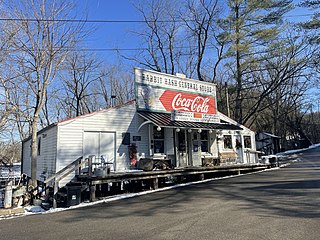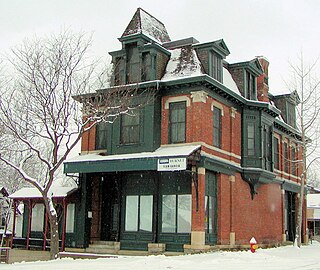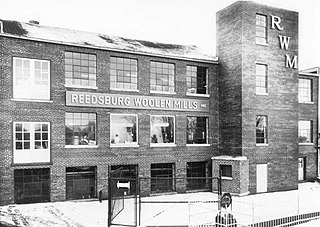
Roxobel is a town in northwestern Bertie County, North Carolina, United States. It dates to 1724 and was originally known as Cotten's Cross Roads. After several name changes, it has remained Roxobel since 1849. The population was 240 at the 2010 census.

The Minnesota State Capitol is the seat of government for the U.S. state of Minnesota, in its capital city of Saint Paul. It houses the Minnesota Senate, Minnesota House of Representatives, the office of the Attorney General and the office of the Governor. The building also includes a chamber for the Minnesota Supreme Court, although court activities usually take place in the neighboring Minnesota Judicial Center.

The Minnesota Historical Society (MNHS) is a nonprofit educational and cultural institution dedicated to preserving the history of the U.S. state of Minnesota. It was founded by the territorial legislature in 1849, almost a decade before statehood. The Society is named in the Minnesota Constitution. It is headquartered in the Minnesota History Center in downtown Saint Paul.

Blue Mounds State Park is a state park of Minnesota, USA, in Rock County near the town of Luverne. It protects an American bison herd which grazes on one of the state's largest prairie remnants.

Rabbit Hash is an unincorporated community and census-designated place (CDP) in Boone County, Kentucky, United States, with a population of 315. It is listed on the National Register of Historic Places. The town is notable for its name, its string of canine mayors, and its historic general store which was largely destroyed by fire in 2016.

The Kentucky Historical Society (KHS) was originally established in 1836 as a private organization. It is an agency of the Kentucky state government that records and preserves important historical documents, buildings, and artifacts of Kentucky's past. The KHS history campus, located in downtown Frankfort, Kentucky, includes the Thomas D. Clark Center for Kentucky History, the Old State Capitol, and the Kentucky Military History Museum at the State Arsenal. KHS is a part of the Kentucky Tourism-Arts and Heritage Cabinet, is fully accredited by the American Alliance of Museums, is a Smithsonian affiliate, and endorses the History Relevance statement. The mission of the KHS is to educate and engage the public through Kentucky’s history in order to confront the challenges of the future. The KHS allows the public access to their resources through the online Library catalog along with the in-person Library.

The Southgate–Lewis House is located one mile east of the Texas State Capitol in Austin, Texas, at 1501 East 12th Street. The house was constructed in 1888, and now stands as an African-American historical landmark. It is also a repository for African-American History and Culture in the region of east Austin, which historically became an African-American neighborhood. The City of Austin has now declared this region to be "Austin's Black Cultural District." The Southgate–Lewis House is located in the center of the "African American Cultural Heritage District".

Oakland Plantation, originally known as the Jean Pierre Emmanuel Prud'homme Plantation, and also known as Bermuda, is a historic plantation in and unincorporated area of Natchitoches Parish, Louisiana. Founded as a forced-labor farm worked by enslaved Black people for White owners, it is one of the nation's best and most intact examples of a French Creole cotton plantation complex. The Oakland Plantation is now owned by the National Park Service as part of the Cane River Creole National Historical Park.

The Schornstein Grocery and Saloon is a commercial/residential building in Saint Paul, Minnesota, United States. It was built in 1884 for $5,000 in the French Second Empire style, and this Dayton's Bluff business was designed by architect Augustus F. Gauger (1852-1929). It is listed on the National Register of Historic Places.

Fire Station No. 19, now the site of a Buffalo Wild Wings, and the architectural firm Station 19 Architects in Minneapolis, Minnesota, United States is centered in the University of Minnesota, Minneapolis campus. The former Fire Station is listed on the National Register of Historic Places. It was built in 1893 in an era when Minneapolis was growing rapidly. Rapid development was bringing prosperity to Minneapolis, but it was also starting to tax the city's infrastructure. Residents and businesses on the east bank of the Mississippi River were demanding better fire protection, especially after the fire that consumed the University of Minnesota Old Main building in 1892 along with some grain elevators nearby. Fire Station No. 19 was built in a simple utilitarian style, yet it contained some touches of ornamentation. It was built with a bell tower that was later removed. The fire station was one of the last to house horse-drawn equipment, as late as 1922, it also had a hardwood floor apparatus bay. A newer Fire Station 19 was occupied in 1976 one block to the south.

This is a list of the National Register of Historic Places listings in Mower County, Minnesota. It is intended to be a complete list of the properties and districts on the National Register of Historic Places in Mower County, Minnesota, United States. The locations of National Register properties and districts for which the latitude and longitude coordinates are included below, may be seen in an online map.

Gen. Philemon Dickinson House is located in Trenton, Mercer County, New Jersey, United States.

Waverly Historic District is a national historic district located at Columbia, South Carolina. The district encompasses 132 contributing buildings in the first suburban development at Columbia. They were built between about 1898 and 1925, and the district includes examples of Queen Anne, Colonial Revival, Neoclassical, shotgun, American Foursquare, and Craftsman/Bungalow style architecture. The community has evolved from a predominantly white neighborhood into a community of African-American artisans, professionals and social reformers.

The Winona Savings Bank Building, now the Winona National Bank Historic Downtown Building, is an Egyptian Revival bank building in Winona, Minnesota, United States. It was designed by Chicago-based architect George W. Maher and constructed from 1914 to 1916. The building was listed on the National Register of Historic Places in 1977 for having state-level significance in the themes of architecture and commerce. It was nominated for being the largest and best preserved of Minnesota's few early-20th-century Egyptian Revival buildings, and one of Maher's master works in the state.

The Stowers Building is located at 820 Fannin Street in downtown Houston. The building was constructed in 1913 and is listed on the National Register of Historic Places (NRHP). The building is named for George Arthur Stowers and his furniture company, which had moved into the new "skyscraper" after a fire at his Main Street store. The local firm of Green & Finger designed the ten-story building which was constructed out of reinforced steel by Pearson & Co. The building was representative of a period of skyscraper construction in Houston between 1908 and 1913. It is listed on the National Register of Historic Places.

The Glenn Building is a historic building on Marietta Street in downtown Atlanta, Georgia, United States. Built in 1923 as an office building, the building was converted to a boutique hotel in 2006 and added to the National Register of Historic Places in 2008.

The Reedsburg Woolen Mill was a historic woolen mill along the Baraboo River in Reedsburg, Wisconsin. The woolen mill was the largest employer in Reedsburg for much of its life, employing over 200 people. The woolen mill was built in 1891 and lasted until 1968, when most of it burned down, leaving the office building intact. It was added to the National Register of Historic Places in 1984.
Two buildings in Pittsburgh were known as the United States Marine Hospital. They were part of the U.S. Marine Hospital system, which was run by the Marine Hospital Service and its successor the Public Health Service, primarily for the benefit of the civilian merchant marine. The original hospital was located in Allegheny City and was used as a Marine Hospital during 1851–1875, after which it was sold. It was demolished in the late 1880s for construction of the Ohio Connecting Railroad Bridge.

F. H. Gillingham & Sons is a historic general store in Woodstock, Vermont. Specializing in retail and mail order, the company was established in 1886 and is operated by the Billings family.

The Ridenour-Baker Grocery Company Building in Kansas City, Missouri is a commercial building constructed in 1910 by the Ridenour-Baker Grocery Company. It was the first wholesale grocery building west of the Mississippi River to be located on the path of a railway, where goods could be shipped into it directly. The building was listed on the National Register of Historic Places in 2014.























